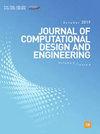具有种群预处理和投影距离辅助消除机制的多目标进化算法
IF 6.1
2区 工程技术
Q1 COMPUTER SCIENCE, INTERDISCIPLINARY APPLICATIONS
引用次数: 0
摘要
摘要基于Pareto优势的多目标进化算法(maoea)面临着多目标问题(MaOPs)的重大挑战。选择压力随着目标数量的增加而减少,而非支配解则呈指数增长。基于Pareto优势的MaOEA通过设计与多样性相关的环境策略增加了选择压力。然而,它仍在努力在人口多样性和趋同之间取得良好的平衡。此外,多样性选择方法增加了选择抗优势解(drs)的可能性,这不利于maea的性能。针对上述问题,提出了一种基于种群预处理和投影距离辅助消除机制(PPEA)的多目标优化算法。在PPEA中,首先设计种群预处理方法来减少drs的负面影响。其次,为了进一步提高基于Pareto优势的maoea平衡种群多样性和收敛性的能力,提出了一种投影距离辅助淘汰机制,将较差的个体逐一剔除,直到种群规模满足终止条件。在一系列具有3-15个目标的基准问题和一个实际应用问题上,将PPEA的性能与7个优秀的maoea进行了比较。实验结果表明,PPEA在处理MaOPs时具有竞争性,能够有效地平衡种群的多样性和收敛性。本文章由计算机程序翻译,如有差异,请以英文原文为准。
A many-objective evolutionary algorithm with population preprocessing and projection distance-assisted elimination mechanism
Abstract Pareto dominance-based many-objective evolutionary algorithms (MaOEAs) face a significant challenge from many-objective problems (MaOPs). The selection pressure reduces as the number of objectives rises, while the non-dominated solution grows exponentially. Pareto dominance-based MaOEA increases the selection pressure by designing diversity-related environmental strategies. However, it still struggles to strike a good balance between population diversity and convergence. Moreover, the diversity-selection method increases the likelihood that dominance-resistant solutions (DRSs) will be chosen, which is detrimental to the performance of MaOEAs. To address the aforementioned problems, a many-objective optimization algorithm based on population preprocessing and projection distance-assisted elimination mechanism (PPEA) is proposed. In PPEA, first, the population preprocessing method is designed to lessen the negative impacts of DRSs. Second, to further improve the ability to balance population diversity and convergence of Pareto dominance-based MaOEAs, a projection distance-assisted elimination mechanism is proposed to remove the poorer individuals one by one until the population size satisfies the termination condition. The performance of PPEA was compared with seven excellent MaOEAs on a series of benchmark problems with 3–15 objectives and a real-world application problem. The experimental results indicate that PPEA is competitive and can effectively balance the diversity and convergence of the population when dealing with MaOPs.
求助全文
通过发布文献求助,成功后即可免费获取论文全文。
去求助
来源期刊

Journal of Computational Design and Engineering
Computer Science-Human-Computer Interaction
CiteScore
7.70
自引率
20.40%
发文量
125
期刊介绍:
Journal of Computational Design and Engineering is an international journal that aims to provide academia and industry with a venue for rapid publication of research papers reporting innovative computational methods and applications to achieve a major breakthrough, practical improvements, and bold new research directions within a wide range of design and engineering:
• Theory and its progress in computational advancement for design and engineering
• Development of computational framework to support large scale design and engineering
• Interaction issues among human, designed artifacts, and systems
• Knowledge-intensive technologies for intelligent and sustainable systems
• Emerging technology and convergence of technology fields presented with convincing design examples
• Educational issues for academia, practitioners, and future generation
• Proposal on new research directions as well as survey and retrospectives on mature field.
 求助内容:
求助内容: 应助结果提醒方式:
应助结果提醒方式:


